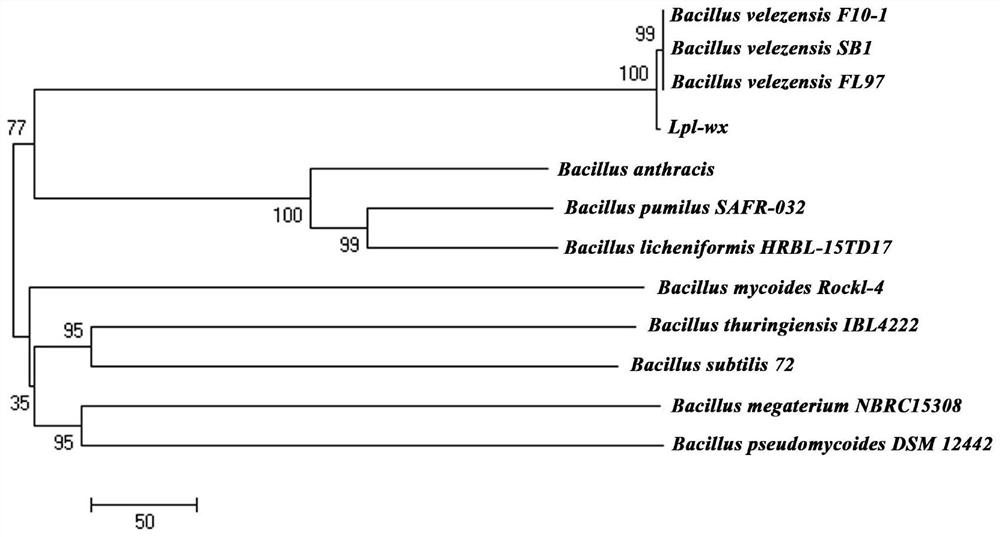Bacillus velezensis and application thereof
A Bacillus and enrichment culture technology, applied in the field of microorganisms, can solve the problems of many by-products, environmental pollution, and high saponification costs, and achieve the effects of high enzyme production efficiency, fast fermentation process, and efficient degradation.
- Summary
- Abstract
- Description
- Claims
- Application Information
AI Technical Summary
Problems solved by technology
Method used
Image
Examples
Embodiment 1
[0055] Screening of high-yield strains of astaxanthin esterase
[0056] Weigh 1g of soil sample, add it to 10mL 0.9% sterile normal saline, fully shake it under the condition of 200r / min, take 1mL supernatant in 50mL enrichment medium after standing still, keep constant temperature at 37℃ and 200r / min Shake culture for 24 hours, transfer 1 mL to a new enrichment medium for the second enrichment, and cultivate for 24 hours under the same conditions for the third enrichment to obtain the enriched bacterial liquid.
[0057] The enrichment medium includes the following components: 0.02% of sucrose, 0.02% of yeast extract powder, 0.05% of sodium chloride, 0.35% of disodium hydrogen phosphate, 0.15% of ammonium sulfate, 0.15% of dipotassium hydrogen phosphate, and 0.05% of anhydrous magnesium sulfate %, olive oil emulsion 1%.
[0058] Dilute the enriched bacterial solution to 10 -6 Double the concentration, the bacteria solution is evenly spread on the Rhodamine B selection medium...
Embodiment 2
[0064] Enzyme Activity Measurement of High-Producing Astaxanthin Esterase Strain
[0065] The method used in the measurement of enzyme activity in this embodiment is titration.
[0066] Olive oil emulsion was used as the substrate for the reaction. Add 50mL phosphate buffer solution and 40mL olive oil emulsion to the reaction system, mix well and react in a water bath at 40°C for 5 minutes, then take it out, add 10mL centrifuged fermentation supernatant to the reaction system, mix well and react in a water bath at 40°C Take it out after 15 minutes, add 15mL of 95% absolute ethanol to terminate the reaction, add two drops of 1% phenolphthalein indicator, and titrate with 0.05mmol / L sodium hydroxide standard solution until the end point of the titration is reddish and does not fade for 30s, record the consumption The volume of 0.05mmol / L sodium hydroxide standard solution.
[0067] x=(Vt–V0) N / Vm t
[0068] In the formula, x is the enzyme activity of the sample, in U / mL; Vt i...
Embodiment 3
[0070] Morphological identification of a strain with high astaxanthin esterase production
[0071] A small amount of the bacterial strains screened in Example 1 were fermented and cultured in the fermentation medium, cultured at 37°C for 24 hours, diluted, spread on a solid plate, cultured at 37°C, observed single colony shape, size, edge, surface, transparency, etc., and Gram staining was carried out, and the morphological characteristics of the strains were observed under an optical microscope.
[0072] Morphological characteristics of colonies: round and neat, smooth and moist colonies, slightly raised. The bacteria are rod-shaped, Gram staining is positive, spores are formed, and they do not expand. Gram stain see figure 1 , spore staining see figure 2 .
PUM
 Login to View More
Login to View More Abstract
Description
Claims
Application Information
 Login to View More
Login to View More - R&D
- Intellectual Property
- Life Sciences
- Materials
- Tech Scout
- Unparalleled Data Quality
- Higher Quality Content
- 60% Fewer Hallucinations
Browse by: Latest US Patents, China's latest patents, Technical Efficacy Thesaurus, Application Domain, Technology Topic, Popular Technical Reports.
© 2025 PatSnap. All rights reserved.Legal|Privacy policy|Modern Slavery Act Transparency Statement|Sitemap|About US| Contact US: help@patsnap.com



